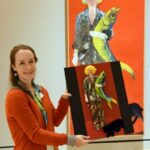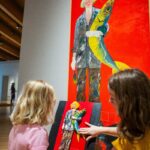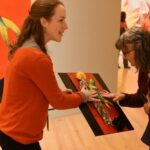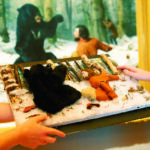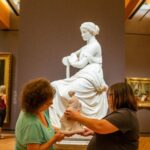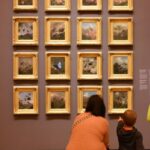A young girl in a museum runs her fingers over the surface of an art display. Instead of painted brushstrokes, she feels the tickling bristles of a paintbrush … the texture of a paint-smeared smock … the silkiness of the artist’s blond hair … a cat’s furry coat … and a cool, scaly fish.
The girl has vision loss. She is “seeing” the painting by touching a miniature version – a “touchable map” – of the original, 8-foot-tall artwork, which hangs on the wall. In the self-portrait, artist Joan Brown stands in a paint-covered smock and pants, holding a brush in one hand and a huge fish cradled in the other arm as a black cat strolls by.
Art for everyone
The museum is Crystal Bridges Museum of American Art in Bentonville. And the interactive display that allows the visually impaired youngster to experience a visual medium was made possible, in part, by a $10,000 grant from Arkansas Blue Cross and Blue Shield.
“In order to create a more welcoming environment for guests with all levels of sight, we have developed what we call touchable paintings,” said Kim Crowell, senior museum educator and accessibility coordinator. “I firmly believe that everyone should have access to arts and culture, regardless of whether or not they have a disability.”
A different way to “see”
A touchable painting is a sensory a map of a work of art. Different textures are used to represent the subject matter the artwork depicts. “When someone feels this touchable map, they can get an idea of where objects in the original artwork are located,” Crowell said. “This is always combined with a highly detailed verbal description of the artwork, which enables the listener to paint a mental picture of what the artwork looks like in their mind’s eye.”
Access for all
The touchable paintings are one aspect of the Access and Inclusion Program, a comprehensive attempt to make Crystal Bridges a welcoming and inclusive environment for guests of all abilities and backgrounds. Crystal Bridges is wheelchair accessible, has provisions for people who have hearing and sight loss and welcomes service animals. There are programs for youth with autism and people who have Alzheimer’s disease/dementia. The museum also provides 3D-printed miniatures of selected sculptures and large-print and braille explanations of exhibits during specific programs and by request.
According to Crowell, this kind of accommodation is unusual for a museum the size of Crystal Bridges. “Typically, when I see these kinds of multi-sensory tours, they are in larger museums in cities like New York or Washington, D.C.,” she said.
Broader strokes
But Crowell is not content with the museum’s current level of accessibility. “There has been significant work in this area, but we have a lot more work to do in order to create the welcoming environment for everyone that we really want. One thing I am really excited about in the future is ways to make our North Forest Trail more accessible for all levels of sight. We are creating 3D scans of some of the works of art on the trail which we will use to create touchable bronze scale models.”
The North Forest Trail is one of eight trails that wind through the 120-acre museum campus. For more on Crystal Bridges, visit the museum’s website.


